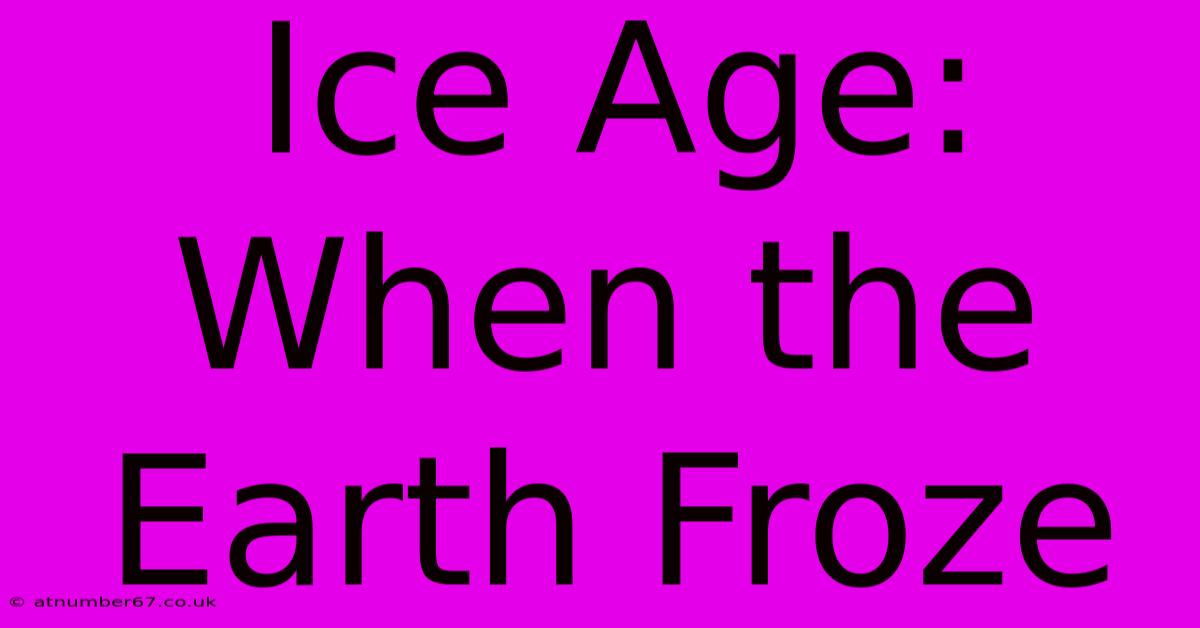Ice Age: When The Earth Froze

Table of Contents
Ice Age: When the Earth Froze – A Deep Dive into the Glacial Periods
The Ice Age. A phrase that conjures images of woolly mammoths, saber-tooth cats, and a world dramatically different from our own. But what exactly was the Ice Age? And how did it shape the Earth we inhabit today? This article delves into the fascinating history of Earth's glacial periods, exploring their causes, effects, and the lasting legacy they've left behind.
Understanding the Ice Ages: More Than Just One Freeze
The term "Ice Age" often leads to confusion. It wasn't a single, continuous period of freezing temperatures. Instead, Earth has experienced numerous ice ages throughout its history, characterized by long periods of glaciation (glacial periods) punctuated by warmer interglacial periods, like the one we're currently in. The most recent ice age, the Quaternary glaciation, began roughly 2.6 million years ago and continues to this day. Within this larger ice age, there have been several glacial cycles, with the last major glacial maximum ending around 11,700 years ago.
What Caused the Ice Ages?
Pinpointing the precise cause of ice ages is a complex scientific endeavor. However, several key factors are believed to have played crucial roles:
-
Milankovitch Cycles: These are variations in Earth's orbital parameters – eccentricity (shape of orbit), obliquity (tilt of axis), and precession (wobble of axis) – that influence the distribution of solar radiation received by the planet. These cyclical changes, over tens of thousands of years, affect the amount of sunlight reaching different latitudes, ultimately influencing global temperatures.
-
Greenhouse Gas Concentrations: The atmospheric concentration of greenhouse gases, such as carbon dioxide and methane, plays a vital role in regulating Earth's temperature. Lower concentrations lead to cooler temperatures, potentially triggering or intensifying glacial periods.
-
Plate Tectonics: The movement of continents can significantly impact ocean currents and atmospheric circulation patterns, influencing global climate. The arrangement of continents and landmasses affects the distribution of heat and ice, thus impacting the likelihood of glacial periods.
-
Albedo Effect: Ice and snow reflect a significant amount of sunlight back into space (high albedo). As ice sheets grow, they increase the Earth's albedo, leading to a positive feedback loop where more sunlight is reflected, further cooling the planet and promoting more ice growth.
The Impact of the Ice Ages: Shaping the World We Know
The Ice Ages profoundly reshaped the Earth's landscape, ecology, and even human evolution. Their effects are still visible today:
Landscape Transformation:
-
Glacial Landforms: Glaciers carved out valleys, created fjords, deposited vast amounts of sediment (creating moraines), and sculpted the landscapes of many regions across the globe. The Great Lakes, for instance, are a direct result of glacial activity.
-
Sea Level Changes: During glacial periods, vast amounts of water were locked up in ice sheets, causing global sea levels to drop significantly. As the ice melted during interglacial periods, sea levels rose.
Ecological Shifts:
-
Megafauna: The Ice Ages were home to iconic megafauna, including woolly mammoths, mastodons, saber-tooth cats, giant ground sloths, and more. Many of these species adapted to the cold, harsh conditions but ultimately faced extinction at the end of the last ice age.
-
Plant Life Adaptations: Plant life also adapted to the changing climates, with the spread of tundra and boreal forests during glacial periods and the expansion of temperate forests during interglacial periods.
Human Evolution:
- Migration and Adaptation: The fluctuating climates and changing landscapes of the Ice Ages likely played a crucial role in the migration and adaptation of early humans. The development of tools and technologies, such as clothing and shelter, were essential for survival in the harsh glacial environments.
The Ongoing Legacy: Understanding Our Present and Future
Understanding the Ice Ages is not merely a historical exercise. It's crucial for comprehending current climate change and predicting future scenarios. By studying past glacial cycles, scientists gain invaluable insights into the complex interplay of factors that govern Earth's climate. This knowledge is essential for developing effective strategies to address the challenges posed by anthropogenic climate change. The lessons learned from the past can help us navigate the complexities of the future.
Keywords: Ice Age, Glacial Period, Interglacial Period, Milankovitch Cycles, Greenhouse Gases, Plate Tectonics, Albedo Effect, Megafauna, Glacial Landforms, Sea Level Changes, Climate Change, Quaternary Glaciation, Woolly Mammoth, Saber-tooth Cat.

Thank you for visiting our website wich cover about Ice Age: When The Earth Froze. We hope the information provided has been useful to you. Feel free to contact us if you have any questions or need further assistance. See you next time and dont miss to bookmark.
Featured Posts
-
Endrick Age The Ultimate Footballer
Apr 02, 2025
-
Harlem Eubank The Man Who Inspired Him
Apr 02, 2025
-
Amr Diabs Age Still Charting At The Top
Apr 02, 2025
-
Hamza Sohails Age A Journey Of Growth
Apr 02, 2025
-
Age Of Consent In Trinidad A Call For Greater Awareness
Apr 02, 2025
